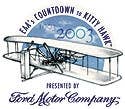
In August of 1900, while still running their bicycle business, the Wright brothers were also beginning to construct their first kite/glider... and searching for a favorable testing ground. Dayton, Ohio, hardly qualified, since winds seldom reached the 12-15 mile per hour strength they felt was necessary to fly and test the machine. Frustrated, Wilbur wrote to Octave Chanute on May 13th, seeking his advice on a "suitable locality where I could depend on winds of about 15 miles per hour without rain or too inclement weather." He also asked Chanute's views on his ideas of launching the kite/glider (perhaps manned) from a 150-foor tower.
In his reply, Chanute nixed the idea of a tower launch as too dangerous. Better, he felt, to try "preliminary learning on a sand hill and ambitious feats over water." He suggested San Diego, California, and Saint James City, Florida, because both offered constant offshore winds, although neither had the advantage of sand. Some other spot "on the Atlantic coast," he felt, might be better.
|| |---| | | | Wilbur found the wind-swept dunes of Kitty Hawk perfect for testing.| Seeking solid information, Wilbur wrote to the U.S. Weather Bureau in Washington, requesting information on prevailing wind conditions in various parts of the country. Chicago was windiest, but Wilbur preferred secluded areas, and he discovered that the sixth-highest average wind in the United States (13.4 mph) had been recorded at Kitty Hawk, North Carolina, which also offered a reasonable number of clear, rain-free days in the fall, with occasional winds much above the average. When Wilbur inquired of the Kitty Hawk Weather Bureau, he received more good news. In addition to favorable wind conditions, Kitty Hawk's mile-wide beach included a bare hill 80 feet high with not a tree or bush anywhere in sight.
A return letter from William Tate, the Kitty Hawk postmaster, was even more enticing. Wrote Tate, "If you decide to try your machine here and come, I will take pleasure in doing all I can for your convenience and success and pleasure, and I assure you will find a hospitable people when you come among us." Wilbure needed no more convincing. Kitty Hawk it would be.
On September 6th, Wilbur made the two-day trek by rail and boat to Kitty Hawk, located on the OUter Banks. Orville soon followed and, like Wilbur was amazed at the three enormous mountains of sand named Kill Devil Hills just south of town, which Orville remarked, "looked like the Sahara, or what I imagine the Sahara to be."
That fall, and the next three autumns, the brothers would travel to the windswept dunes of Kitty Hawk... where they painstakingly prepared and were finally able to make history.
This "Kitty Hawk Moment" is brought to you by the EAA, whose Countdown to Kitty Hawk program, presented by Ford Motor Company, includes an exact flying reproduction of the Wright Flyer. It is the centerpiece of the EAA's national tour during 2003, which will conclude with a five-day celebration at Kitty Hawk, North Carolina, where the Wright Flyer will fly again at exactly 10:35 a.m. on December 17, 2003, commemorating 100 years of powered flight.
www.countdowntokittyhawk.org

Sign-up for newsletters & special offers!
Get the latest FLYING stories & special offers delivered directly to your inbox






